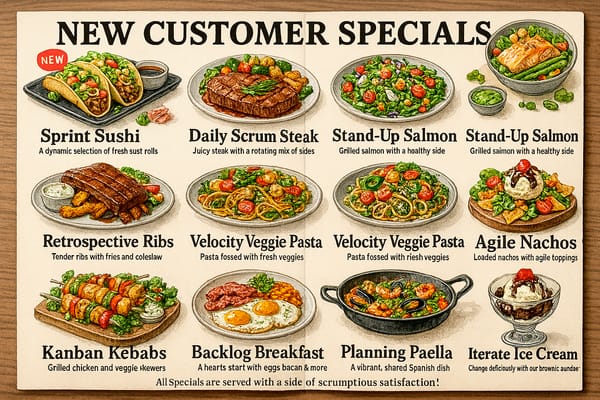Prioritise progress over all else
How does your delivery team spend most of their time?

When it comes to the success of a delivery team, there's one measure that immediately helps understand their situation.
Where do they spend the majority of their time?
A simple way to track this is by splitting types of work into just two. Doing, and not doing.
Progressing their top priority
The important one is the time they spent making progress on the single most important project on their radar. The doing.
Yes, I said single most. One. Primary. First.
"Oh, but we have more than one really important..." Sure. Everybody does. Until they don't.
Ask yourself this question. If you could finish any active project today, knowing all other projects would not move an inch until tomorrow, which one would it be?
Everything else
You have the project. All other work goes into the other bucket. ‘Not doing’.
That’s all planning, calls, tracking time, admin, meetings, other projects, new business, training. Literally all other tasks.
Balance
If you do this process honestly and accurately, you'll most likely find that two things are true...
1. On average your delivery team spend more time on 'everything else' than they do on 'the top priority'. Less than 50% of time is on 'doing' their most important project.
Now this doesn't mean less than 50% of their time is billable, but it does mean Priority Project Progress (3P) isn't the main focus of their work.
You don't need me to expand further.
2. The chunks of time they spend on 3P is split into small chunks. Usually less than 2 hours.
The chunks are carved out between meetings, planning, calls and other projects, rather than the other way around.
And not all time is equal. Focus is key to flow, and quality output and not wasting time context switching.
Trying it out
Most time-tracking software allows reporting which would quickly surface a 3P% for your team. Or you could export data to a spreadsheet and calculate your 3P% without too much work.
From there, take your baseline and set a target to improve each week. 5% a week would be an achievable change for most teams to begin with, especially those on less than 50% 3P. Remember that the aim isn't 100%. You want a clear prioritisation, but not obsession over just one project at the cost of all other business areas.
The target will likely need reviewing every week or two.
Not all time is equal
There are many factors which determine how valuable - progress in a positive direction - an hour of somebody’s time will be.
It might be how they slept, or if they’ve had a coffee. It could be the time of day, or what they’ve eaten.
Many things are worth experimenting with, but what is already well known and documented is the importance of two key factors...
Avoid context switching
In busy agencies things change quickly, and the multiple projects which run at the same time need attention.
Chat messages fly, and quick calls and meetings help leaders to keep everything moving.
But what’s often hidden is the true impact of the messages and calls which can be quickly scheduled into any hour of any day.
Interruptions, and even planned switches between projects require members of the delivery team to empty their brain of the thing they were working on. Park the work safely to return to later. Then upload all the details and context of the new topic, swiftly, so they can be useful to the current conversation.
The process takes time, adds risk, and ultimately uses energy that could be assigned to valuable progress.
A state of flow
Whether often or occasional, you’ll know the feeling of getting a lot done in a seemingly short amount of time. The clock moving more slowly. Only the current task being in your thoughts for long periods of time.
This is flow. Deep focus on a single task. It results in better quality, more progress.
It’s good to encourage and support it for any knowledge workers in your team.
That naturally means fewer interruptions and actively protecting periods of focus.
Shooting for the moon
If you want to take this even further, here are more ways to further increase the velocity of your team...
1. Weekly shared priority
At the start of your team's week, name the single most important project for them. Pin it on a wall, or whiteboard or in Teams or Slack.
Make a commitment not to change the priority.
2. Share the 3P%
Being aware of the 3P% and doing some basic work to improve it is one thing, but allowing team members to make changes to their own ways of working is the next level.
Share the 3P% data - ideally in realtime from time tracking software - with the team so they can feed back on it.
3. Single focus days
Have regular days with only a single focus. Confirm the project, ensure there is nothing blocking anybody, and ensure there won't be the usual regular interruptions.
One great way of keeping on task is to pair with another team member. With two sets of eyes on the work, it not only improves the quality, but it stops the desire to just check emails, or Slack from becoming a context switch.
4. Encourage reducing waste
Not everything that teams create is valuable. Often requirements are vague enough that a team member will decide how complex or detailed to be in delivery.
Encouraging the reduction of waste - or to see it another way, a focus on value - results in each task taking less time, and more opportunities to share, without risking the disappointment of clients.
5. Larger blocks of time
Make the main part of every day a block of doing time.
Sure, bookend it with emails, meetings, a stand up, planning, new business, calls, whatever, but the middle of the day - many hours - is blocked for 3P. Genuine progress time.
6. Actively reduce 'Everything Else'
Regularly review where the team's time is going. Find places it can be reduced by:
- Turning meetings into emails
- Reducing the size of meeting attendance
- Shortening meetings and calls
Summary
Solving problems with a delivery team's progress should rarely start with processes and tools. The primary issue is often just having the time to work on the one thing that matters most.
Experiment with your team's ways of working to make 3P a thing, and let me know how you get on.
Header photo by Stefan Cosma on Unsplash




